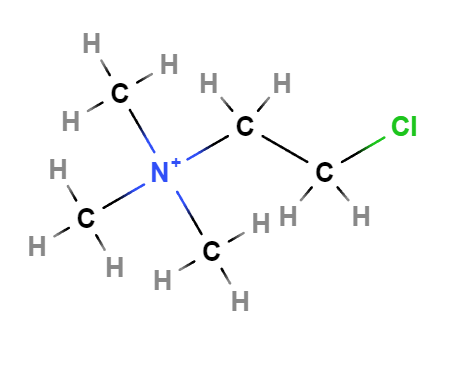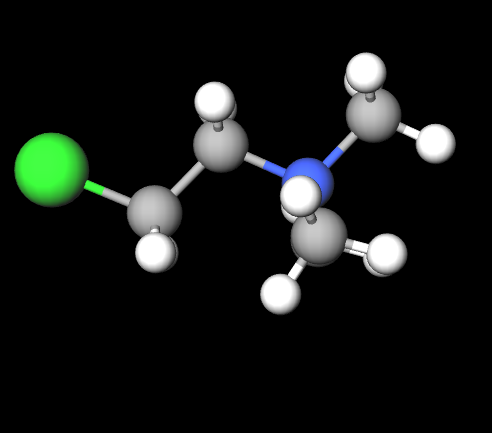| "Descrizione" by Al222 (20718 pt) | 2024-Feb-20 10:06 |
Chlormequat is a plant growth regulator widely used in agriculture to promote more compact plant development and improve resistance to lodging. It is also known as chlormequat chloride and belongs to the class of growth regulators called growth retardants. Its use is widespread in crops such as cereals, vegetables, and ornamental plants to control plant height and facilitate harvesting.
Composition. Chlormequat is a chemical compound with the formula C5H13ClN+. It acts by inhibiting the biosynthesis of gibberellin, a plant hormone that regulates growth and development.
Properties. By reducing gibberellin production, chlormequat limits cell elongation in plants, resulting in more compact and robust development. This helps prevent lodging in crops like wheat, improving plant stability and yield (1).
Use. It is applied as a foliar or soil treatment at various stages of plant growth to optimize crop structure and productivity.
Benefits and Limitations. While chlormequat offers significant benefits in controlling plant growth and increasing yields, its effectiveness can vary depending on environmental conditions, crop type, and agricultural practices.
Chemical Industrial Synthesis Process
The chemical synthesis of Chlormequat, beyond its common form as Chlormequat chloride, can follow specific synthetic pathways to obtain the base molecule. Here is a general overview of the process.
- Selection of Reagents. The synthesis of Chlormequat can start from chemical precursors such as ethylene chloride and dimethylamine, which are key reagents for forming the base structure of Chlormequat.
- Synthesis Reaction. Ethylene chloride reacts with dimethylamine in the presence of a catalyst or under alkaline conditions to form the base compound of Chlormequat. This reaction may require controlled temperature and pressure conditions to optimize yield.
- Product Purification. The reaction product, Chlormequat, is purified to remove any impurities or by-products. Purification can include methods such as distillation, crystallization, or chromatography.
- Quality Control. The purified Chlormequat undergoes quality control testing to ensure it meets the required specifications. These tests can include spectroscopic analyses, chromatographic analyses, and purity tests.
Safety
The safety of chlormequat for use in agriculture has been assessed by various regulatory authorities. It is important to follow specific usage instructions and recommended doses to minimize risks to human health and the environment (2).
As with many agrochemicals, the use of chlormequat requires caution to avoid water contamination and negative impacts on non-target ecosystems. Sustainable management practices and adherence to regulations can reduce these risks.
 |  |
Molecular Formula C5H13ClN+
Molecular Weight 122.62 g/mol
CAS 7003-89-6
UNII 8SUZ1123XX
Nikkaji J933D
DTXSID4048064
Synonyms
- Cycocel
References_____________________________________________________________________
(1) Henriksen T, Juhler RK, Brandt G, Kjaer J. Analysis of the plant growth regulator chlormequat in soil and water by means of liquid chromatography-tandem mass spectrometry, pressurised liquid extraction, and solid-phase extraction. J Chromatogr A. 2009 Mar 20;1216(12):2504-10. doi: 10.1016/j.chroma.2009.01.050.
Abstract. We present a new, precise and accurate method for quantitative analysis of chlormequat in soil and aqueous matrices. The method, which is based on LC-MS/MS, pressurised liquid extraction and solid-phase extraction, is eminently suitable for studying the fate of chlormequat in the soil environment. The limit of detection is 0.003-0.008 microg/L for rainwater, surface water and groundwater and 0.07-0.4 microg/kg for soil. In water samples amended to 0.04 microg/L, precision is better than 10%. The residual content of chlormequat in three agricultural topsoils analysed 4 months after its application was 23-55 microg/kg (12-23% of the amount applied). No trace of chlormequat was detected in groundwater from 66 water supply wells located in rural areas treated with chlormequat.
(2) Juhler RK, Vahl M. Residues of chlormequat and mepiquat in grain--results from the Danish National Pesticide Survey. J AOAC Int. 1999 Mar-Apr;82(2):331-6. PMID: 10191539.
Abstract. The objective of the present work was to establish information on chlormequat and mepiquat residues in grain for human consumption. Chlormequat (2-chloro-N,N,N-trimethylethylammonium, CAS RN 7003-89-6) and mepiquat (1,1-dimethylpiperidinium, CAS RN 15302-91-7) are plant growth regulators used to stabilize stalks in cereals. The study was part of the Danish National Pesticide Survey, managed by the Danish Veterinary and Food Administration. Samples were collected in autumn 1997. Residue contents were determined with a newly developed liquid chromatographic-tandem mass spectrometric (LC-MS/MS) method for chlormequat analysis. The method was extended to include mepiquat in the present study. Quantitation was done by the internal standards method, using mass chromatograms of the most intense daughter ions of mepiquat (m/z 98), chlormequat (m/z 58), and [13C]-chlormequat (m/z 61, internal standard). For chlormequat, the overall limit of detection (LD) was 6 micrograms/kg and the limit of determination (LOD) was 10 micrograms/kg. For mepiquat, LD was 2 micrograms/kg and LOD was 3 micrograms/kg. Of 77 samples analyzed, 51 contained chlormequat and 11 contained mepiquat. The highest levels of chlormequat were found in samples of oatmeal (3.76 mg/kg) and rye (1.08 mg/kg). In 9 rye grain samples containing chlormequat, 5 also contained mepiquat. However, in all samples analyzed, the residues of chlormequat and mepiquat were below maximum residue limits.
European Food Safety Authority (EFSA). Statement on the dietary risk assessment for the proposed temporary maximum residue level for chlormequat in oyster mushrooms. EFSA J. 2019 May 9;17(5):e05707. doi: 10.2903/j.efsa.2019.5707. PMID: 32626328; PMCID: PMC7009251.
| Evaluate |

